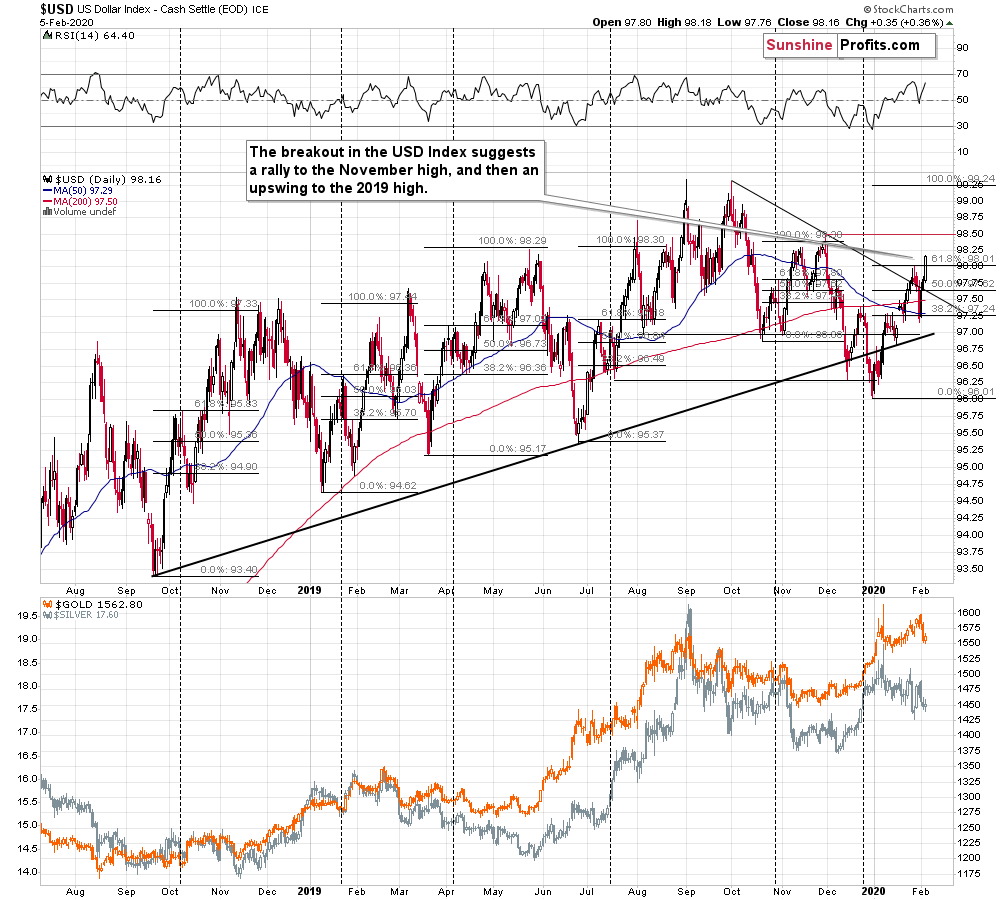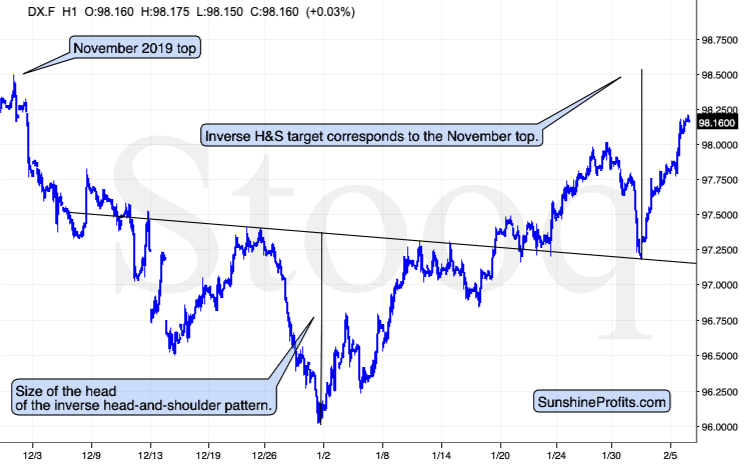Briefly: in our opinion, full speculative long position (150% of the regular position size) in silver is justified from the risk/reward point of view at the moment of publishing this Alert.
The precious metals market didn't do much yesterday, but - what may seem surprising - that's quite bullish. It's bullish, because the USD Index rallied to new yearly highs and this "should have" caused the PMs and miners to decline. It didn't, which suggests that the decline is not yet ripe for continuation.
In this case, the most likely scenario is that we'll see another rebound in gold, silver, and mining stocks as soon as the USD Index corrects. Then, PMs could form their final top, and the big decline could begin.
Alternatively, this cycle of back and forth movement could continue a bit longer. Gold could spike, but only if the coronavirus scare gets much worse, as we outlined yesterday. If that happens, silver and miners are not likely to be affected to the same extent as gold - just like what happened in 2014 during the ebola scare.
The above might be confusing so let's put it in other words, simplifying.
PMs showed resilience yesterday, suggesting that they are likely to rally once USDX corrects.
When the USDX corrects, PMs are likely to rally and silver might outperform gold at that time, as that might be the final part of PMs' rally.
What may or may not be related to the above is the peak interest in (fear of) the coronavirus. When that happens gold would be likely to rally higher and to outperform silver and mining stocks.
Our plan here is to take profits off the table in case of the silver position during silver's outperformance and then perhaps open a short position in it and mining stocks. In gold, we will be more hesitant to open a short position until we see more fear of the coronavirus. When we do, it will mean that gold is getting close to its local high.
Ok, so, when could the USD Index correct triggering another move up in the precious metals sector?
USD Index Has Momentum
Quite likely relatively soon. The USD Index broke above its declining resistance line and moved to new yearly highs yesterday. The momentum is strong so it could reach its November 2019 high as soon as today.
Now, based on the recent local high (the one that was just broken), we can estimate how high the USD Index is likely to move in the next few weeks. This can be done thanks to the Fibonacci extensions technique. In short, it means multiplying the size of the previous rally by 1.618.
In practice, we can do it by using the Fibonacci... retracement tool, but drawing it in a way that anchors the start of the retracement at the initial bottom, and then placing the 61.8% Fibonacci retracement at the initial top. The 100% "retracement" now points to the target. Why would the "retracement" work in this way? Because 100% / 61.8% = 1.618 (approximately) That's one of the very specific properties of the Phi number. Others include that 1 / 0.618^2 = 2.618 (approximately) and many more.
But the math behind it is not that important - what is important is that it very often works.
In all cases that we marked on the above chart, this technique pointed to important short-term tops. Currently, it points to a top being likely at about 99.24. This is the 2019 high, which makes this level very likely to stop the USD Index... for some time. After all, the USD Index is in a powerful uptrend - it's likely to exceed its previous highs despite short-term pullbacks.
So why do you mention the November 2019 high, while it is THE 2019 high that's likely to be reached?
Because the USD Index might not rally to the 2019 high without an intermediate correction. Please note what happened in the cases that we applied the Fibonacci extension to. In all cases, except for the July rally, the USD Index first formed an initial high, corrected, and only then moved to the Fibonacci-extension-based target.
The November high is the next strong (from the short-term point of view) resistance and it's confirmed also by a short-term inverse head-and-shoulders pattern.
The target is based on the size of the head of the pattern and it quite clearly confirms the target based on the November 2019 high.
Summary
Summing up, the USD Index is likely to correct after reaching about 98.5 (the November 2019 high), which is likely to trigger a very short-term upswing in gold and silver. Then the greenback is likely to rally once again and PMs might fall (unless the coronavirus scare peaks, in which case gold could move higher once again for several days). The short-term top in gold and silver is quite likely to be formed this week or early next week.
The medium-term outlook is very bearish and once the short-term correction is over, the declines are likely to resume.
As always, we'll keep you - our subscribers - informed.
To summarize:
Trading capital (supplementary part of the portfolio; our opinion): Full speculative long position (150% of the full position) in silver is justified from the risk/reward perspective with the following stop-loss orders and binding exit profit-take price levels:
- Silver futures: profit-take exit price: $17.89; stop-loss: $17.24; initial target price for the USLV ETN: $90.47; stop-loss for the USLV ETN: $82.95
Long-term capital (core part of the portfolio; our opinion): No positions (in other words: cash)
Insurance capital (core part of the portfolio; our opinion): Full position
Whether you already subscribed or not, we encourage you to find out how to make the most of our alerts and read our replies to the most common alert-and-gold-trading-related-questions.
Please note that the in the trading section we describe the situation for the day that the alert is posted. In other words, it we are writing about a speculative position, it means that it is up-to-date on the day it was posted. We are also featuring the initial target prices, so that you can decide whether keeping a position on a given day is something that is in tune with your approach (some moves are too small for medium-term traders and some might appear too big for day-traders).
Plus, you might want to read why our stop-loss orders are usually relatively far from the current price.
Please note that a full position doesn't mean using all of the capital for a given trade. You will find details on our thoughts on gold portfolio structuring in the Key Insights section on our website.
As a reminder - "initial target price" means exactly that - an "initial" one, it's not a price level at which we suggest closing positions. If this becomes the case (like it did in the previous trade) we will refer to these levels as levels of exit orders (exactly as we've done previously). Stop-loss levels, however, are naturally not "initial", but something that, in our opinion, might be entered as an order.
Since it is impossible to synchronize target prices and stop-loss levels for all the ETFs and ETNs with the main markets that we provide these levels for (gold, silver and mining stocks - the GDX ETF), the stop-loss levels and target prices for other ETNs and ETF (among other: UGLD, DGLD, USLV, DSLV, NUGT, DUST, JNUG, JDST) are provided as supplementary, and not as "final". This means that if a stop-loss or a target level is reached for any of the "additional instruments" (DGLD for instance), but not for the "main instrument" (gold in this case), we will view positions in both gold and DGLD as still open and the stop-loss for DGLD would have to be moved lower. On the other hand, if gold moves to a stop-loss level but DGLD doesn't, then we will view both positions (in gold and DGLD) as closed. In other words, since it's not possible to be 100% certain that each related instrument moves to a given level when the underlying instrument does, we can't provide levels that would be binding. The levels that we do provide are our best estimate of the levels that will correspond to the levels in the underlying assets, but it will be the underlying assets that one will need to focus on regarding the signs pointing to closing a given position or keeping it open. We might adjust the levels in the "additional instruments" without adjusting the levels in the "main instruments", which will simply mean that we have improved our estimation of these levels, not that we changed our outlook on the markets. We are already working on a tool that would update these levels on a daily basis for the most popular ETFs, ETNs and individual mining stocks.
Our preferred ways to invest in and to trade gold along with the reasoning can be found in the how to buy gold section. Additionally, our preferred ETFs and ETNs can be found in our Gold & Silver ETF Ranking.
As a reminder, Gold & Silver Trading Alerts are posted before or on each trading day (we usually post them before the opening bell, but we don't promise doing that each day). If there's anything urgent, we will send you an additional small alert before posting the main one.
Thank you.
Sincerely,
Przemyslaw Radomski, CFA
Editor-in-chief, Gold & Silver Fund Manager





